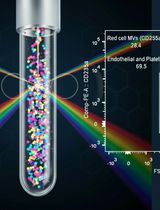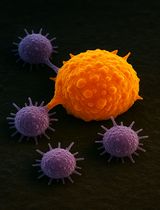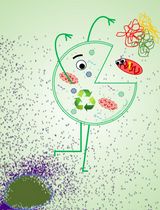- EN - English
- CN - 中文
Flow Cytometry Measurement of Glucocerebrosidase Activity in Human Monocytes
人单核细胞中葡萄糖脑苷脂酶活性的流式细胞术检测
发布: 2020年04月05日第10卷第7期 DOI: 10.21769/BioProtoc.3572 浏览次数: 5744
评审: Maria NguyenVemika ChandraSébastien Gillotin

相关实验方案

外周血中细胞外囊泡的分离与分析方法:红细胞、内皮细胞及血小板来源的细胞外囊泡
Bhawani Yasassri Alvitigala [...] Lallindra Viranjan Gooneratne
2025年11月05日 919 阅读
Abstract
Glucocerebrosidase (GCase) is an important enzyme for the metabolism of glycolipids. GCase enzyme deficiency is implicated in human disease and the efficient measurement of GCase activity is important for evaluating the efficacy of therapeutics targeting this enzyme. Existing approaches to measure GCase activity include whole blood mass spectrometry-based assays, where an internal standard is used to measure the accumulation of ceramide following metabolism of the synthetic substrate C12-glucocerebroside, and the utilisation of fluorescent probes that bind active GCase and/or release fluorescent metabolites upon cleavage by GCase. Here, we describe the application of a fluorescence-activated cell sorter-based assay to efficiently quantitate GCase enzyme activity in the monocyte population of human peripheral blood mononuclear cells. The cell-permeable GCase substrate 5-(Pentafluorobenzoylamino) Fluorescein Di-beta-D-Glucopyranoside (PFB-FDGlu) provides a means to measure GCase activity, whereby enzymatic cleavage yields the green-fluorescent PFB-F dye, detectable in the FL-1 channel of a flow cytometer. An inhibitor of lysosomal GCase activity, conduritol B-epoxide, is employed to ensure specificity. This protocol provides an advantageous approach for measuring GCase activity in living individual cells.
Keywords: Glucocerebrosidase (葡萄糖脑苷脂酶)Background
Glucocerebrosidase (GCase), encoded by the GBA1 gene, is a lysosomal hydrolase that converts glucosylceramide to glucose and ceramide. Loss of function homozygous, and compound heterozygous missense mutations in GBA1 are associated with the accumulation of glucosylceramide and the lysosomal storage disorder Gaucher’s disease (Sidransky, 2012). Whereas heterozygous mutations in GBA1 are associated with increased risk of developing the neurodegenerative movement disorder Parkinson’s disease (PD) (Sidransky and Lopez, 2012). While GBA1 mutations occur in approximately 5-15% of PD cases (Neumann et al., 2009; Sidransky et al., 2009; Lesage et al., 2011), reduced GCase activity is also observed in PD patients without GBA1 mutations (Murphy et al., 2014; Alcalay et al., 2015; Atashrazm et al., 2018), and there is increasing evidence supporting the notion that restoring GCase function is a valid therapeutic option for PD (Schapira 2015; Sardi et al., 2018). Subsequently, a number of small molecule chaperones have been described that can restore GCase function (Khanna et al., 2010 and 2012; Patnaik et al., 2012; McNeill et al., 2014).
The assessment of GCase activity in PD patients can help inform which patients may benefit from such therapies, by identifying those with reduced enzyme activity. Assessment of GCase activity could also be used to gauge the efficacy of proposed therapies to restore GCase function. The efficacy of chaperone-based therapies for restoring GCase function have predominantly been assessed by measuring changes in GCase protein by immunoblotting, or by indirectly measuring GCase activity using mass spectrometry-based assays. Although these approaches have proven useful and do have advantages (Wolf et al., 2018), they are also limited in their ability to distinguish between blood cell types, assay GCase activity in intact living cells, and are potentially less clinically amenable than other techniques. Another current approach to measuring GCase activity involves the use of the non-natural substrate 4-MUG (4-Methylumbelliferyl β-D-galactopyranoside), which when cleaved by GCase produces the fluorescent product 4-methylumbelliferon (4-MU). However, 4-MUG is also a substrate for non-lysosomal GCase (encoded by GBA2) (Boot et al., 2007) requiring the purification of lysosomes or performing the assay at distinguishing pH to add specificity.
The current protocol presented here utilises a selective lysosomal GCase substrate 5-(Pentafluorobenzoylamino) Fluorescein Di-beta-D-Glucopyranoside (PFB-FDGlu), which is metabolised by GCase to yield fluorescein. PFB-FDGlu is cell permeable and can be used with a flow cytometer to measure GCase activity in living cells on a single-cell basis. This protocol has been adapted from earlier studies describing and validating the use of PFB-FDGlu for assessing GCase activity, primarily in the context of Gaucher’s disease (Lorincz et al., 1997; van Es et al., 1997; Rudensky et al., 2003). The ability to combine PFB-FDGlu with other phenotypic indicators, such as a viability stain and antibodies to label cell surface markers is advantageous, as it enables identification of distinct target cell populations in which GCase activity may be modulated.
Materials and Reagents
- Ethanol wipes (Livingstone, catalog number: LWMS )
- Plasters (Livingstone, catalog number: ASP23N )
- Needles 23G (BD Biosciences, catalog number: 367288 )
- BD vacutainer one-use holders (BD Biosciences, catalog number: 364815 )
- BD CPT sodium citrate Vacutainer Glass Cell Preparation Tubes (BD Biosciences, catalog number: 362782 )
- 10 μl XL Biotix Filter Tip (Interpath, catalog number: M00119FC )
- 100 μl Aerosol Barrier Tip (Interpath, catalog number: 24600 )
- 1,000 μl Aerosol Barrier Tip (Interpath, catalog number: 24800 )
- Falcon 5 ml round bottom polystyrene test tube with cell strainer cap, 12 x 75 mm (In Vitro Technologies, catalog number: FAL352235 )
- 1.5 ml EppendorfTM Safe-Lock microcentrifuge tubes (Sigma-Aldrich, catalog number: T9661 )
- Countess cell counting chamber slides (Life Technologies, catalog number: C10312 )
- Sterile syringe filter 0.22 µm (Millipore, catalog number: SLGVV255F )
- 1.5 ml and 15 ml centrifuge tubes
- PPE (lab coat, safety glasses, disposable gloves)
- MilliQ water
- Ice box and ice
- RPMI 1640 Medium (Thermo Fisher Scientific, catalog number: 1187093 )
- Fetal Bovine Serum (FBS) (Thermo Fisher Scientific, catalog number: 10100147 )
- Dimethyl sulfoxide (DMSO) (Sigma-Aldrich, catalog number: D2438 )
- Penicillin-Streptomycin (100x) (Thermo Fisher Scientific, catalog number: 15140122 )
- L-Glutamine (Thermo Fisher Scientific, catalog number: 25030081 )
- CD3 for T-lymphocytes (BD Biosciences, catalog number: 560365 )
- CD19 for B-lymphocytes (BD Biosciences, catalog number: 555415 )
- CD16 for non-classical monocytes (BD Biosciences, catalog number: 560475 )
- 5-(Pentafluorobenzoylamino) Fluorescein Di-beta-D-Glucopyranoside (PFB-FDGlu) (Thermo Fisher Scientific, catalog number: P11947 )
- PE-Cy7 Mouse Anti-Human CD14 antibody (BD Biosciences, catalog number: 557742 )
- PE-Cy7 Mouse IgG2a, k Isotype Control (BD Biosciences, catalog number: 557907 )
- 1x DPBS (Ca2+/Mg2+ free) (Thermo Fisher Scientific, catalog number: 14190144 )
- 1 M HEPES (Sigma-Aldrich, catalog number: H0887 )
- Ethylenediaminetetraacetic acid disodium salt dihydrate (EDTA) (Merck, catalog number: E5134 )
- Sodium Hydroxide (NaOH) (Merck, catalog number: 221465 )
- Trypan blue 0.4% (Thermo Fisher Scientific, catalog number: T10282 )
- Culture media (500 ml) (see Recipes)
- 0.1 M EDTA solution (500 ml) (see Recipes)
- Fluorescence-activated cell sorting (FACS) Buffer (500 ml) (see Recipes)
- CBE 50 mM stock solution (see Recipes) (Sigma-Aldrich, catalog number: C5424-5MG )
- PFB-FDGlu 37.5 mM stock solution (see Recipes)
Equipment
- Tube rack to hold 1.5, 5, 15 ml tubes
- Class II Biosafety cabinet
- Micropipettes (P10, P100, P1000)
- S1 Pipette Filler (Thermo Fisher Scientific, catalog number: 9521 )
- Heraeus Multifuge X1 Centrifuge with inserts for 15 ml conical tubes (Thermo Fisher Scientific)
- Centrifuge (Eppendorf, model: 5415 R )
- Countess II FL automated cell counter (Thermo Fisher Scientific)
- Hotplate magnetic stirrer
- Magnetic stir bar
- Magnetic stirring pad
- pH meter
- 4 °C refrigerator
- -20 °C freezer
- 37 °C 5% CO2 incubator
- Vortex
- Flow cytometer equipped with a 488 nm laser and 530 nm-FITC filter (i.e., BD LSR Fortessa X-20)
- Computer for analysis
Software
- BD FACSDivaTM software (BD Biosciences)
- FlowJo software (Tree Star, OR, USA)
- GraphPad Prism software (GraphPad Software Inc., CA, USA)
Procedure
文章信息
版权信息
© 2020 The Authors; exclusive licensee Bio-protocol LLC.
如何引用
Hughes, L. P., Halliday, G. M. and Dzamko, N. (2020). Flow Cytometry Measurement of Glucocerebrosidase Activity in Human Monocytes. Bio-protocol 10(7): e3572. DOI: 10.21769/BioProtoc.3572.
分类
细胞生物学 > 基于细胞的分析方法 > 酶学测定
生物化学 > 蛋白质 > 荧光
细胞生物学 > 基于细胞的分析方法 > 流式细胞术
您对这篇实验方法有问题吗?
在此处发布您的问题,我们将邀请本文作者来回答。同时,我们会将您的问题发布到Bio-protocol Exchange,以便寻求社区成员的帮助。
提问指南
+ 问题描述
写下详细的问题描述,包括所有有助于他人回答您问题的信息(例如实验过程、条件和相关图像等)。
Share
Bluesky
X
Copy link










